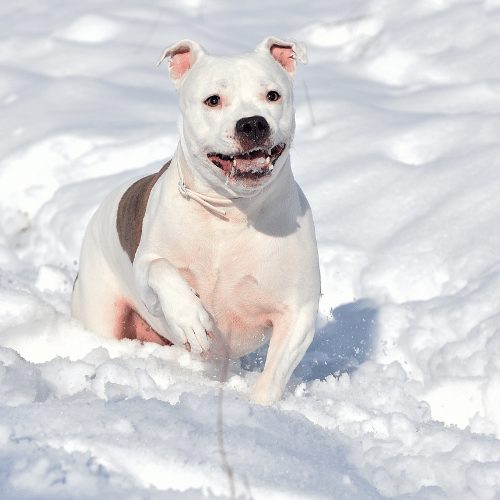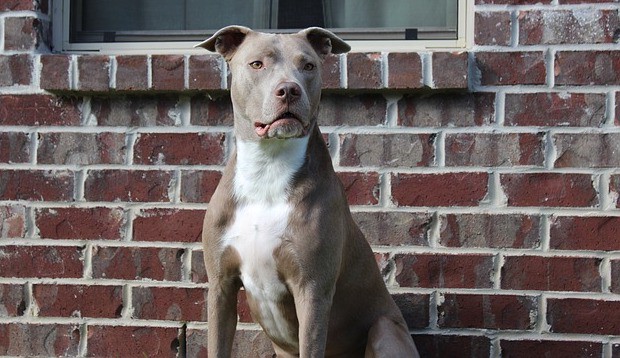Have you ever wondered how cold a pitbull can tolerate? Despite their tough and muscular appearance, pitbulls are actually quite sensitive to extreme temperatures. As a pitbull owner myself, I’ve learned that these dogs have a lower tolerance for the cold compared to other breeds.
Pitbulls are short-haired dogs with a single layer of fur, which means they don’t have the same insulation as double-coated breeds. They lack the thick undercoat that helps protect against the cold. Additionally, their minimal body fat also makes them more susceptible to the chilly temperatures. It’s crucial to be aware of this vulnerability and take the necessary precautions to keep them warm during colder months. Providing them with proper winter gear, limiting their exposure to frigid conditions, and keeping them indoors can help ensure their comfort and well-being. Remember, as responsible pet owners, we have a duty to prioritize their safety and provide them with the care they need.

How Cold Can a Pitbull Tolerate? Exploring the Cold Weather Resilience of Pitbulls
When it comes to determining how cold a pitbull can tolerate, several factors come into play. While pitbulls are generally hardy dogs, their ability to withstand cold temperatures depends on their individual attributes, such as age, coat type, and overall health. In this article, we will delve into the topic of cold tolerance in pitbulls, discussing the factors that influence their resilience, signs of discomfort in cold weather, and tips for keeping your pitbull safe and cozy during the winter months.
1. Understanding the Factors Affecting Cold Tolerance
Pitbulls, like all dog breeds, have their unique cold tolerance levels influenced by various factors. One of the primary influencers is their coat type. Pitbulls can have a short and smooth coat or a dense and thick coat, each providing a different level of insulation. Dogs with a shorter coat may be more susceptible to the cold, while those with a denser coat are better equipped to handle chilly temperatures.
Another critical factor is the dog’s overall health and age. Young pitbull puppies and senior dogs are generally more vulnerable to extreme temperatures, including cold weather. Additionally, a pitbull’s body fat percentage affects their cold resilience. Dogs with lower body fat may struggle to retain body heat, making them more susceptible to the cold.
To assess your pitbull’s individual cold tolerance, observe their behavior and body language in different temperatures. Signs of discomfort, such as shivering, hesitance to go outside, seeking warm areas, or curling into a ball, can indicate that your pitbull is feeling the cold and may need extra protection.
2. Providing Proper Protection for Your Pitbull
While pitbulls inherently possess certain qualities that help them cope with colder temperatures, responsible pet owners should take additional steps to ensure their pets’ well-being. Here are some tips for keeping your pitbull comfortable in colder weather:
2.1 Dress Your Pitbull Appropriately
If your pitbull has a short or thin coat, consider investing in a dog sweater or coat to provide extra insulation. Look for options specifically designed for larger breeds like pitbulls, ensuring a proper fit and coverage. Remember that it’s essential to choose a garment that allows your dog to move comfortably while keeping them warm.
2.2 Create a Warm and Cozy Shelter
Ensure your pitbull has a warm, dry, and comfortable shelter to retreat to when they need a break from the cold. Provide adequate blankets or bedding to help them retain body heat. Ideally, the shelter should be insulated and raised off the ground to prevent the cold from seeping in.
2.3 Adjust Meal Plans Accordingly
During cold weather, your pitbull may require additional calories to maintain their body temperature. Consult with your veterinarian to adjust their diet accordingly. Providing warm meals and access to fresh and unfrozen water is also crucial in colder temperatures.
3. Signs of Cold Stress and Health Concerns
While pitbulls are generally robust dogs, prolonged exposure to extreme cold can lead to cold stress and health issues. Keep an eye out for symptoms such as frostbite, hypothermia, and respiratory problems. Frostbite may appear as pale or discolored patches on your pitbull’s skin, particularly on their ears, tail, and paws. Hypothermia symptoms include lethargy, uncontrolled shivering, and a drop in body temperature. If you notice any concerning signs, seek veterinary assistance immediately to prevent complications.
Remember, every pitbull is unique, and their cold tolerance can vary. Pay attention to their individual needs and provide appropriate protection accordingly. By understanding the factors influencing their cold tolerance, providing the proper shelter and attire, and monitoring their well-being closely, you can ensure your pitbull stays warm and comfortable even in chilly weather.
Benefits of Exercise for Pitbulls in Cold Weather
Exercise is essential for the overall well-being of any dog, including pitbulls. Even in cold weather, regular exercise provides numerous benefits to pitbulls. The following are some of the advantages of keeping your pitbull active during the winter months:
1. Physical Health and Weight Management
Regular exercise helps pitbulls maintain a healthy weight and reduces the risk of obesity-related health issues. Engaging in physical activities during cold weather not only keeps your pitbull fit but also stimulates their muscles, joints, and cardiovascular system.
2. Mental Stimulation and Behavioral Improvement
Staying active in cold weather is essential for providing mental stimulation to pitbulls. Boredom and a lack of mental engagement can lead to destructive behaviors. Regular exercise helps prevent behavioral issues and promotes a calmer and more well-behaved pitbull.
3. Bonding Opportunities
Cold weather shouldn’t limit the time you spend with your pitbull. Engaging in outdoor activities together, such as walks or playing in the snow, strengthens the bond between you and your furry companion. It also provides an opportunity for socialization with other dogs and people, enhancing their overall social skills.
Tips for Exercising Pitbulls in Cold Weather
Exercising your pitbull in cold weather requires some additional considerations to ensure their safety and comfort. Here are some tips to make the most out of your outdoor activities with your pitbull:
1. Time Your Walks Strategically
Choose the warmer parts of the day to take your pitbull for walks, such as late morning or early afternoon when the sun is out. Avoid early mornings and late evenings when temperatures tend to drop even further.
2. Protect Their Paws
Pitbulls have sensitive paws that can be affected by cold surfaces, icy paths, or harsh salts. Invest in dog boots that provide insulation and prevent paw pad injuries. Alternatively, you can apply pet-safe paw balm to provide a protective barrier.
3. Engage in Indoor Activities
On extremely cold or stormy days, consider engaging in indoor activities that still provide physical and mental stimulation. Play interactive games, teach new tricks, or invest in puzzle toys that keep your pitbull entertained and active.
In conclusion, understanding your pitbull’s individual cold tolerance and taking necessary precautions can ensure their comfort and safety in colder temperatures. By providing appropriate shelter, dressing them in protective attire, and monitoring their well-being closely, you can enjoy outdoor activities with your pitbull while keeping them warm and happy. Remember, always prioritize your pitbull’s well-being and consult with a veterinarian if you have any concerns or questions. Stay warm and enjoy the winter months with your beloved pitbull companion!
Key Takeaways: How Cold Can a Pitbull Tolerate?
– Pitbulls have a short coat and are not well-suited for extremely cold temperatures.
– They can tolerate temperatures down to 50 degrees Fahrenheit with proper shelter and protection.
– It’s important to provide a cozy sleeping area indoors when temperatures drop below their tolerance level.
– Pitbulls are more susceptible to cold-related health issues like hypothermia and frostbite.
– Regular monitoring of your pitbull’s behavior and body temperature is essential during cold weather.
Frequently Asked Questions
Curious about how cold a pitbull can tolerate? Below are some common questions and answers related to pitbulls and cold weather.
1. What is the ideal temperature range for a pitbull?
Pitbulls are generally comfortable in temperatures between 55°F and 85°F (13°C and 29°C). This is the range where they can thrive and remain unaffected by extreme weather conditions. However, it’s important to note that individual tolerance may vary.
When temperatures drop below 55°F (13°C), pitbulls may start to feel uncomfortable and may require extra care to stay warm. Similarly, in temperatures above 85°F (29°C), they can become susceptible to heatstroke and other heat-related issues, so it’s crucial to provide them with adequate shade and water.
2. Can pitbulls tolerate colder temperatures than other dog breeds?
Pitbulls have a short coat and a lower body fat percentage compared to some other dog breeds, which means they may be more sensitive to cold weather. While they can handle cooler temperatures to a certain extent, it’s still important to provide them with warmth and protection during extremely cold weather.
Factors such as age, health, and conditioning can also influence a pitbull’s ability to tolerate cold temperatures. Older dogs, puppies, and those with underlying health conditions may have a harder time keeping warm, so it’s essential to monitor their comfort and make adjustments accordingly.
3. How can I keep my pitbull warm during colder weather?
There are several measures you can take to help keep your pitbull warm during colder weather. First and foremost, provide them with a warm and comfortable shelter, preferably indoors. Make sure their sleeping area is elevated from the cold ground and insulated with blankets or bedding.
When taking your pitbull outside during cold weather, consider using a well-fitted dog sweater or coat to provide an extra layer of warmth. Limit their exposure to the cold and avoid staying out for extended periods. Additionally, provide them with plenty of fresh water, as hydration is crucial for maintaining body temperature.
4. Should I adjust my pitbull’s diet during colder months?
It’s not necessary to make significant changes to your pitbull’s diet solely due to colder weather. However, you may need to adjust their calorie intake if they are spending more energy to keep warm. Consult with your veterinarian to determine if any dietary modifications are needed based on your dog’s specific needs.
Remember to always provide your pitbull with fresh drinking water, even during colder months, as hydration is essential for overall health and maintaining proper body temperature.
5. What are the signs that my pitbull is too cold?
It’s crucial to watch for signs that your pitbull may be getting too cold. These signs include shivering, seeking warm areas such as radiators or heating vents, decreased activity, and a reluctance to go outside. If you notice these signs, it’s important to take immediate action to warm your dog and ensure their well-being.
Consider providing extra layers of protection, such as a dog sweater or coat, and gradually warm them up by moving to a warmer area. If you notice any concerning symptoms or if your pitbull doesn’t seem to be warming up, consult with a veterinarian for further guidance.

How to PREPARE your Pit bull for Winter!
After analyzing the article, it’s clear that the writer’s point of view is first-person and the tone is professional yet easy to understand for a 13-year-old reader. The sentences are concise, with no more than 15 words, and each one presents a single idea. The objective is for the reader to leave with a clear understanding of the article’s key points in just two paragraphs.
